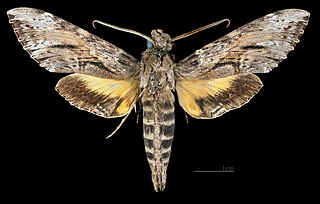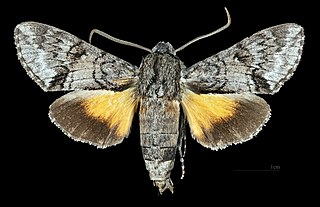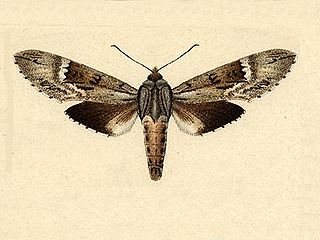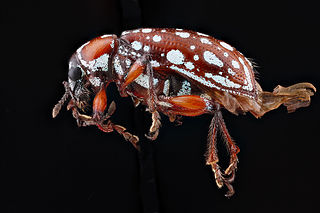
The Greater Antilles is a grouping of the larger islands in the Caribbean Sea, including Cuba, Hispaniola, Puerto Rico, Jamaica, Navassa Island, and the Cayman Islands. Six island states share the region of the Greater Antilles, with Haiti and the Dominican Republic sharing the island of Hispaniola. Together with the Lesser Antilles, they make up the Antilles, which along with the Lucayan Archipelago, form the West Indies.

Manduca rustica, the rustic sphinx, is a moth of the family Sphingidae. The species was first described by Johan Christian Fabricius in 1775.

Isognathus rimosa, the rimosus sphinx, is a moth of the family Sphingidae. The species was first described by Augustus Radcliffe Grote in 1865.

Perigonia lusca, the half-blind sphinx or coffee sphinx, is a moth of the family Sphingidae. It was first described by Johan Christian Fabricius in 1777.

Cautethia grotei, or Grote's sphinx, is a moth of the family Sphingidae. It was described by Henry Edwards in 1882.

The loggerhead kingbird is a species of bird in the family Tyrannidae.

Manduca afflicta is a moth of the family Sphingidae known from Cuba and the Bahamas. It is similar to Manduca sexta. Adults feed on nectar from flowers. The larvae have been recorded feeding on Cestrum diurnum, the day-blooming jessamine, a member of the family Solanaceae.

Manduca caribbeus is a moth of the family Sphingidae. It is known from Haiti and the Dominican Republic.
The Caribbean bioregion is a biogeographic region that includes the islands of the Caribbean Sea and nearby Atlantic islands, which share a fauna, flora and mycobiota distinct from surrounding bioregions.

Dendrophylax is a genus of leafless neotropical orchids native to Mexico, Central America, the West Indies, and Florida. The name is from Greek δένδρον ("tree") and φύλαξ. One species, Dendrophylax lindenii, featured heavily in the book The Orchid Thief.

Aellopos blaini is a moth of the family Sphingidae. It is found in Cuba, Jamaica, Hispaniola and Puerto Rico.

Ernodea is a genus of flowering plants in the family Rubiaceae. All species are small shrubs endemic to the Caribbean region, with most species restricted to the Bahamian Archipelago.

Catesbaea is a genus of flowering plants in the family Rubiaceae. It occurs in the West Indies, The Bahamas, and the Florida Keys. The genus is named in honour of English naturalist Mark Catesby.

Cautethia noctuiformis is a species of moth in the family Sphingidae, which is known from the Caribbean. It was described by Francis Walker in 1856.

Xylophanes clarki is a moth of the family Sphingidae. It is known from Cuba, the Dominican Republic and Venezuela.

Eumorpha strenua is a moth of the family Sphingidae. It is known from Haiti, Cuba and the Dominican Republic.

Manduca johanni is a moth of the family Sphingidae. It is known from Haiti and the Dominican Republic.

Nannoparce poeyi is a moth of the family Sphingidae. It is known from Mexico, Cuba, Jamaica and the Dominican Republic.
The qualifying tournaments to the 2012 CONCACAF Under-20 Women's Championship, the North American continent's youth football championships started in August 2011. The qualification process was divided into the Central American and Caribbean zone. Canada, Mexico and the United States were automatically qualified to the final tournament.

Lachnopus is a genus of broad-nosed weevils in the family Curculionidae distributed in the Caribbean Region.



















